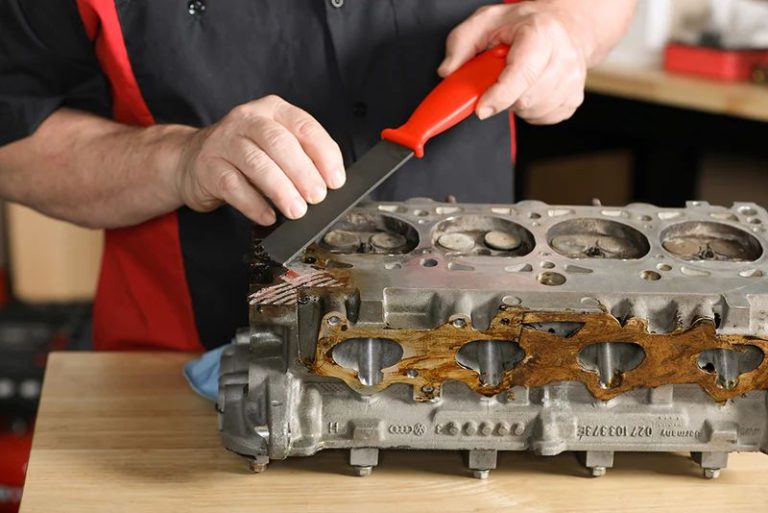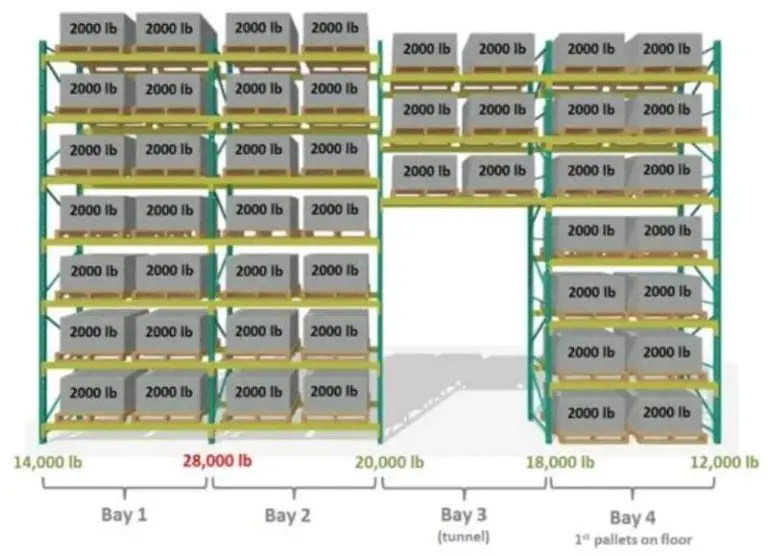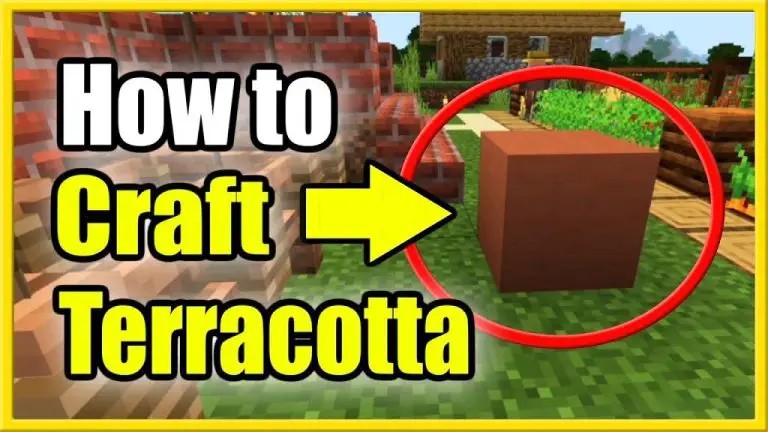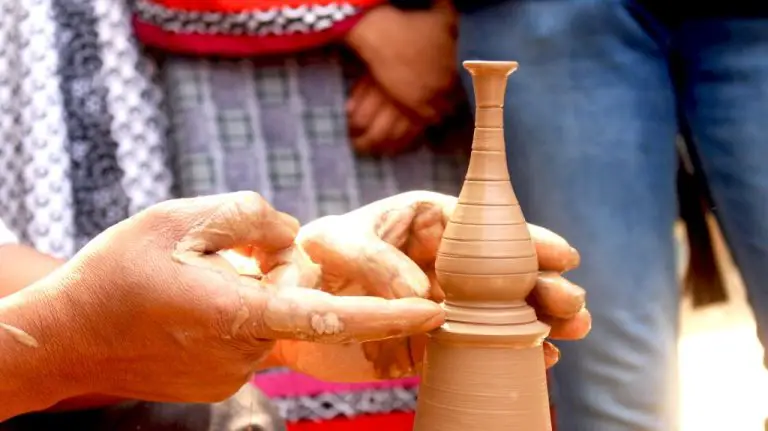What Is Pottery In Simple Terms?
What is Pottery?
Pottery refers to ceramic material that has been shaped or molded and then hardened by heating or drying. Pottery is one of the oldest human inventions, originating before the Neolithic period, with ceramic objects like the Gravettian culture Venus of Dolní Věstonice figurine discovered in the Czech Republic dating back to 29,000–25,000 BC. According to the Merriam-Webster dictionary, the definition of pottery is “ceramic ware (such as earthenware, stoneware, or porcelain) made from clay and hardened by heat.”
Pottery produced from clay constitutes a distinct art form based on the potter’s ability to shape and form objects from malleable clay through techniques like throwing, molding, hand building, and other methods. Pottery can be contrasted with mass-produced ceramic shapes from molds like bricks or tiles. Whereas those products emphasize regularity and repeatability, pottery emphasizes uniqueness and variability in the artist’s technique and expression.
As an ancient global craft, pottery represents a unique intersection of art, culture, and function. Pottery artifacts reflect the distinctive styles and values of the cultures that produced them and the intended utility of the objects themselves. From decorative vases to cooking pots to storage vessels, pottery has served as one of humanity’s most ubiquitous and enduring art forms.
Sources:
https://en.wikipedia.org/wiki/Pottery
https://www.merriam-webster.com/dictionary/pottery
History of Pottery
Pottery making began in the Neolithic period, around 10,000 BCE, when early civilizations first started settling in one area and growing their own food. Some of the earliest pottery has been found at archaeological sites in China and Japan, dating back over 18,000 years. Pottery was invented independently in various places around the world.
The earliest pottery vessels were made by hand, without the use of a wheel. Early pots were made by shaping clay coils into a vessel shape and smoothing the surfaces. Firing pottery in a kiln became possible around 6000 BCE, which made pots stronger and more water resistant. Glazing and decoration also began during this period.
Around 3500 BCE, the potter’s wheel was invented in Mesopotamia. This revolutionized pottery production and allowed pots to be made much faster and more uniform in size and shape. The wheel was introduced to Egypt around 3000 BCE and then spread to Europe and Asia. Wheel-thrown pottery quickly became popular around the ancient world.
Over the centuries, pottery developed many different styles and techniques in cultures around the world, such as Greek Black and Red Figure pottery, Chinese porcelain, and Italian Majolica. Today, pottery continues to thrive as both functional ware and art.
Sources:
Wikipedia article on Pottery
Deneen Pottery article on history of pottery
Types of Pottery
The three main types of pottery are earthenware, stoneware, and porcelain.
Earthenware is pottery that has been fired at lower temperatures, typically between 1,800-2,000°F. It is porous and less durable than other types of pottery. Common types of earthenware include terra cotta, faience, and majolica. Earthenware is used for making flower pots, dishes, mugs, and decorative items. Historical examples include ancient Greek painted vases and Native American pottery. 1
Stoneware is fired at higher temperatures around 2,200-2,400°F making it denser and more durable than earthenware. It is non-porous and holds water without leaking. Stoneware maintains its strength when used for cooking and serving food. It is commonly used to make crocks, jugs, and cooking pots. Notable examples include jian tea wares from China. 2
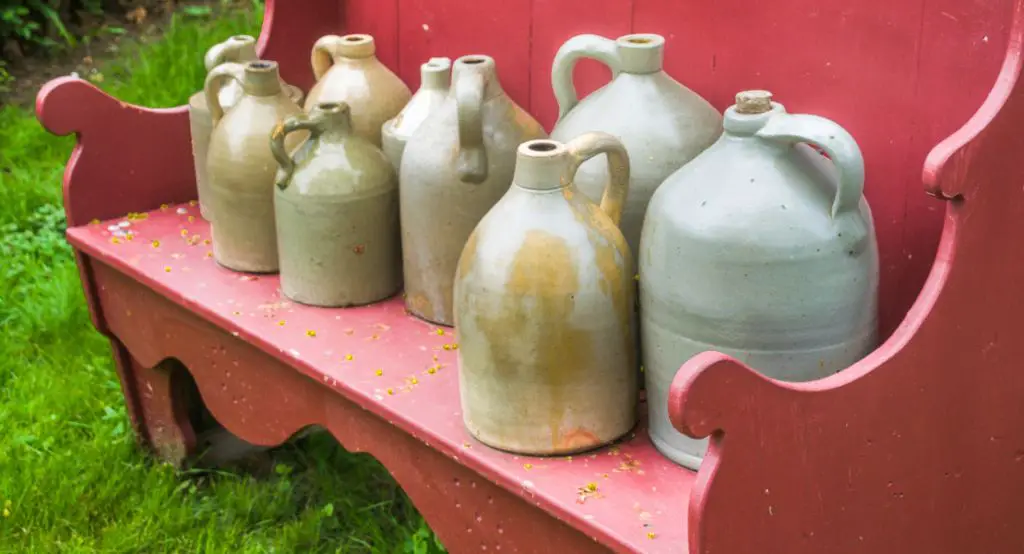
Porcelain is the strongest type of pottery, fired at very high temperatures over 2,400°F. It develops a glassy finish and becomes completely non-porous. Porcelain is known for its whiteness, translucency, and sonorous ring. It was first made in China during the Tang dynasty. Porcelain is ideal for making tableware and art objects. Well-known porcelain wares include Chinese blue and white porcelain and Meissen porcelain.
Pottery Techniques
There are several main techniques used in pottery creation:
Hand Building: This involves shaping clay by hand without the use of a pottery wheel. Some common handbuilding techniques include:
- Pinching – squeezing clay between the thumb and fingers
- Coiling – rolling thin ropes that are stacked to build height
- Slab Building – rolling flat sheets that can be cut into shapes and joined together
Molding: This involves pressing soft clay into a mold to create a desired shape. The mold can be made of plaster, wood, clay, silicone, or other materials.
Wheel Throwing: This is done on a pottery wheel and involves centering a ball of clay on the wheel head and using various techniques to raise and shape the walls of a vessel.
Some key wheel throwing methods are pulling up walls, collaring, and trimming excess clay from the base when the form is partially dry. Wheel throwing allows for symmetry and uniform wall thickness.(https://www.couling.com/basic-pottery-techniques/)
Clay Materials
The three main types of clay used in pottery are earthenware, stoneware, and porcelain. Each type has different characteristics that determine what it’s best used for.
Earthenware is a low-fire clay that is fired at lower temperatures, typically between 1,800°F – 2,000°F. It can be porous and is not vitrified, meaning it absorbs water. Earthenware clays are very workable and come in a wide range of colors like red, brown, and terracotta. They are commonly used for flower pots, decorative items, and tiles. According to SIO-2 Earthenware Clays, Low Fire, some popular earthenware clays are Redart, G-Mix 5, and Valdosa.
Stoneware clays are fired at higher temperatures, usually between 2,200°F – 2,400°F. The higher firing makes stoneware less porous and more durable than earthenware. Stoneware has good thermal properties and resists shock. It comes in various colors like grey, blue, white, reddish-brown. Stoneware is commonly used to make crockery, jugs, and other functional items. According to Stoneware Clay for Pottery, some popular stoneware clays are Highwater, Speckled Buff, and Super White.
Porcelain is fired at the highest temperatures, between 2,200°F – 2,450°F. It’s highly vitrified and non-porous, making it bright white, translucent, and strong. Porcelain is commonly used for tableware, artware, and sanitaryware. It has high plasticity for shaping and modeling. Some popular porcelain clays are XL10, FG-67, and FG-170 according to moist porcelain clay bodies.
Glazing and Decorating
Glazing and decorating are final processes in making pottery that add color, design, and finish to completed pieces. Glazes are mixtures of minerals and metal oxides like silica, borax, and soda ash that are applied to greenware or bisqueware before firing to create a glass-like coating.
There are many techniques for decorating pottery including:
- Glazing – Using colored glazes like underglazes, overglazes, and slips to coat the pottery.
- Slip Trailing – Using a slip, which is liquid clay, to draw designs on pieces before firing.
- Sgraffito – Scratching through a layer of colored slip to reveal the clay body underneath.
- Mishima – Incising a design through slip into the clay body.
- Inlay – Pressing colored clays into carved areas to create geometric patterns.
- Stamping – Impressing designs into clay using wood, rubber, or clay stamps.
- Engraving – Cutting designs into leather-hard clay using metal tools.
Glazing and decoration allow potters to add beautiful colors, textures, and patterns to their finished pieces. The options for embellishing pottery are nearly endless. (Source)
Firing Pottery
Firing is the term used for heating pottery in a kiln to high temperatures to cause permanent changes. There are multiple stages to the firing process including bisque firing, high-fire glaze firing, and raku firing for different effects.
Bisque firing is done on unglazed clay after it has dried. It heats the pottery to around 1800-2200°F which causes all the water and chemical components to burn out of the clay leaving the pottery porous and ready for glazing and decorating. Bisque firing makes the pottery durable but not waterproof. According to The Pottery Wheel, bisque firing usually takes 6-12 hours to complete based on factors like the size of the kiln and pieces.[1]
The high-fire glaze firing happens after the pottery has been glazed. Glazes melt and fuse to the clay body during this firing stage typically between 2200-2400°F. The glaze makes the pottery vitreous, non-porous, and waterproof. Complete high-fire glaze firing can take 8-16 hours.
Raku firing is a specialized technique originating from Japan. Pottery is heated quickly at 1600-1800°F then removed from the hot kiln and exposed to air. This causes dramatic crackled glaze effects. Raku firings are much faster taking only 30-60 minutes.
[1] https://thepotterywheel.com/stages-of-firing-clay/
Notable Potters
Some of the most famous and influential potters through history include Bernard Leach, Shoji Hamada, Lucie Rie, and Michael Cardew.
Bernard Leach (1887-1979) was a British studio potter who is considered the “Father of British studio pottery.” He studied pottery in Japan and combined Anglo-Oriental traditions in his work. Leach emphasized simplicity, functionality, and naturalness in his pottery. His book “A Potter’s Book” (1940) was very influential on studio potters. (Source)
Shoji Hamada (1894-1978) was a Japanese potter along with Leach who helped popularize the Mingei folk-art movement. His work combined traditional Japanese forms with modern, simple aesthetics. Hamada spent time working with Leach in England in the 1920s before returning to Japan. He became known for shino glazes and forms like chawan tea bowls. (Source)
Other notable potters include Lucie Rie (1902-1995), a Vienna-born British potter known for her modernist stoneware forms, and Michael Cardew (1901-1983), a British potter who helped revive traditional English slipware techniques.
Pottery Wheel
The pottery wheel has been an essential tool for potters for thousands of years. The earliest evidence of the potter’s wheel dates back to Mesopotamia circa 3500-3000 BCE. It is believed the potter’s wheel was independently invented in many cultures throughout Asia, Africa, and Europe as civilization advanced. The potter’s wheel enabled potters to produce uniform round pots more quickly and efficiently than with handbuilding techniques.
A pottery wheel is a mechanical device used in the shaping of round ceramic ware. It consists of a spinning disk known as a bat on a base, with a flywheel that momentum from the user kicking a kick wheel or from an electric motor. As the wheel spins, the potter shapes the clay into symmetrical articles using their hands and various tools. The momentum of the spinning wheel enables manipulation of the clay much easier than shaping the clay statically.
Modern pottery wheels fall into one of several categories:
– Kicking wheels – rotated by the user’s own momentum kicking the flywheel
– Treadle wheels – operated by the user with their feet via a pedal system like a foot powered spinning wheel
– Electric wheels – powered by an electric motor and rotation speed controlled by a foot pedal
Beginners typically start on a simple kicking wheel before advancing to more complex wheels with additional features. Major pottery wheel manufacturers include Shimpo, Brent, American Potter’s Wheels, and Lekk.
Modern Pottery
Contemporary pottery refers to pottery made in the late 20th and early 21st centuries. Modern potters draw inspiration from various sources including nature, architecture, and traditional pottery methods to create innovative designs and forms.
Some characteristics of modern pottery include unusual shapes, asymmetrical forms, bold colors, and abstract patterns. Many modern potters use experimental materials and techniques as well, such as raku firing, soda glazing, and combining clay with other materials like metal or wood.
Well-known contemporary pottery artists include Peter Voulkos who is known for his abstract sculptural vessels, Shoji Hamada who combined Japanese folk art with modernist forms, and Arlene Shechet who creates complex layered ceramic sculptures.Modern pottery can be found for sale on sites like Etsy, in galleries, museums, and directly from the artists.

